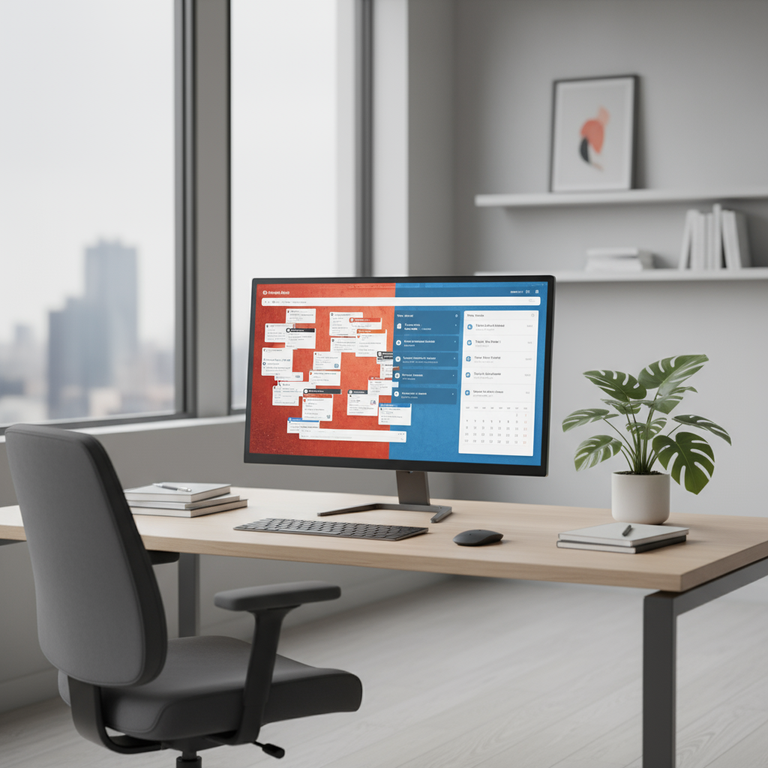Essentialism: The Practical Guide to Doing Less (But Better) in Your Professional Life
Our professional culture is drowning in a paradox: we are working more, yet achieving less. We are constantly “busy”—drowning in emails, back-to-back meetings, and endless to-do lists—but this busyness rarely translates into meaningful progress on the things that truly matter. We’ve been sold a lie that “more” is always better: more projects, more clients, more hours. The result is a workforce that is overworked, overwhelmed, and fundamentally ineffective.
This is the “Non-Essentialist” trap. It’s the default state for most professionals today. The antidote is not better time management; it’s an entirely new way of thinking. This is Essentialism. Popularized by author Greg McKeown, Essentialism is not about getting more things done; it’s about getting the *right* things done. It’s about systematically identifying what is absolutely essential, and then courageously eliminating everything that is not.
This is not minimalism. Minimalism is about “less for the sake of less.” Essentialism is a strategic discipline. It is the practical guide to doing less (but better) in your professional life, so you can make your highest possible contribution. This guide will show you how.
What is Essentialism? (And Why It’s a Strategy, Not a ‘Hack’)
At its core, Essentialism is the disciplined pursuit of less. It’s a rejection of the idea that we can (and should) do it all. A “Non-Essentialist” operates under the assumption that every opportunity is equally valuable, so they say “yes” by default. An “Essentialist” operates with the knowledge that most opportunities are trivial, and a select few are vitally important. They say “no” by default.
This mindset shift changes everything. It moves you from a reactive state (“What’s the most urgent thing I have to do?”) to a proactive, strategic state (“What is the single most important thing I *should* be doing?”).
The Non-Essentialist thinks: “I have to.”
The Essentialist thinks: “I choose to.”
The Non-Essentialist thinks: “It’s all important.”
The Essentialist thinks: “Only a few things *really* matter.”
By adopting Essentialism, you stop being a simple “order taker” in your own life and become a strategic editor. You stop asking, “How can I do it all?” and start asking, “What is the one thing I can do that will make everything else easier or unnecessary?” This is the core of doing less (but better).
The 3-Step Framework for Practical ‘Essentialism’
Essentialism is not a vague philosophy; it is a three-part system. You must practice these three steps in order, consistently, for the methodology to work. It is a continuous cycle, not a one-time event.
Step 1: EXPLORE (Discerning the Trivial Many from the Vital Few)
The first step is to become a world-class filter. You cannot identify the “vital few” if you don’t give yourself the time and space to explore your options. Ironically, this phase of Essentialism requires you to look at *more* things, but to do so with a highly critical eye.
A Non-Essentialist gets an email and immediately adds it to their to-do list. An Essentialist pauses and asks, “Is this *really* essential? Does this align with my highest-level goals?”
How to do it:
- Use the 90% Rule: When evaluating an opportunity or a task, score it from 0 to 100 on how essential it is. If it’s not a 90% or higher, treat it as a 0%. This forces you to reject “good” opportunities and only accept “great” ones.
- Identify Your “Highest Point of Contribution”: Ask yourself, “What is the *one thing* I am uniquely suited to do that adds the most value to my team or project?” Any task that falls outside of this should be viewed with extreme skepticism.
- Focus on the Outcome: Don’t look at the *activity*; look at the *result*. Which 20% of your activities are producing 80% of your results (the Pareto Principle)? Double down on those, and stop the rest.
Step 2: ELIMINATE (The Courageous Art of the Graceful ‘No’)
This is the hardest part of Essentialism in practice. Once you’ve identified the “trivial many,” you must have the courage to eliminate them. This means saying “no” to your boss, your colleagues, your clients, and even to your own “good” ideas. This is not about being difficult; it’s about protecting your ability to deliver on what truly matters.
Saying “no” gracefully is a core skill of doing less (but better). Most of us avoid it to prevent short-term social awkwardness, but in doing so, we commit to long-term mediocrity. A “yes” to a non-essential task is an implicit “no” to an essential one.
How to do it:
- Separate the Decision from the Relationship: When you say “no,” make it clear you are rejecting the *request*, not the *person*. “I’m not the right person for this right now” is different from “I don’t want to help you.”
- Use the “Yes, but…” (or “No, and…”) Method: Instead of a hard “no,” offer a trade-off. To your boss: “I can absolutely take on that new project. To do it well, I will need to deprioritize Project Y. Which one is the higher priority for you right now?” This reveals the hidden cost of the new “yes.”
- The “Awkward Pause”: When someone makes a request, just pause. Count to three. Often, the person will fill the silence themselves and may even backtrack on the request’s urgency.
- “Let me check my calendar and get back to you”: This is a simple buffer that gives you time to move from a reactive “yes” to a thoughtful “no.”
Step 3: EXECUTE (Creating a System for Effortless Action)
Exploring and eliminating is useless if you can’t execute on the few essential things you have left. The final step of Essentialism is to build a system that makes execution as frictionless as possible. The goal is to remove obstacles and create routines so that your essential work doesn’t just get done—it gets done *well*.
This is where you stop doing less and start doing better. You invest the time and energy you saved from eliminating the non-essentials and reinvest it into the quality of your most important work.
How to do it:
- Create Buffers: A Non-Essentialist assumes a “best-case scenario” timeline. An Essentialist knows that *something* will always go wrong. They build in a 50% buffer to their timelines and budgets. This buffer is what allows you to handle unexpected problems without derailing your entire plan.
- Protect “The Asset”: The most important asset for WINNING in your professional life is *you*—your brain and your body. Essentialism means protecting your ability to perform. This includes non-negotiable sleep (8 hours), time for deep work (your first 90 minutes), and time for play and rest. Burnout is the ultimate non-essential state.
- Start with the Hardest Thing: Do your most essential, high-impact task first thing in the morning, before the chaos of the day takes over. This “small win” builds momentum and ensures that even if the rest of your day is reactive, you have already accomplished your highest-priority goal.
- Focus on the “Minimal Viable Progress”: Stop thinking about “perfect.” Focus on “done.” What is the absolute minimum you need to do to make progress today? This focus on small, consistent steps is how you achieve doing less (but better).
Conclusion: ‘Essentialism’ Is Not a Choice, It’s a Discipline
The path of the Non-Essentialist is easy. It requires no tough choices; you just say “yes” to everything. But this path leads to a career defined by inches of progress in a million different directions. It is the fast-track to burnout and regret.
Essentialism is the harder, more disciplined path. It requires constant trade-offs, uncomfortable conversations, and the courage to reject good opportunities. But this is the only path that allows you to make massive progress in the few directions that truly count.
This is not a one-time clean-up. Essentialism is a new way of operating, a new discipline you must practice every single day. Stop asking “How much can I do?” and start asking “What is the right thing to do?” That is the practical, powerful secret to doing less (but better).







